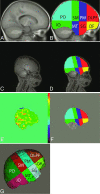Regional cerebral blood flow in children from 3 to 5 months of age
- PMID: 24091444
- PMCID: PMC7964707
- DOI: 10.3174/ajnr.A3728
Regional cerebral blood flow in children from 3 to 5 months of age
Abstract
Background and purpose: Understanding the relationship between brain and behavior in early childhood requires a probe of functional brain development. We report the first large study of regional CBF by use of arterial spin-labeling in young children.
Materials and methods: Cerebral blood flow by use of arterial spin-labeling was measured in 61 healthy children between the ages of 3 and 5 months. Blood flow maps were parcellated into 8 broadly defined anatomic regions of each cerebral hemisphere.
Results: There was no sex effect; however, group analysis demonstrated significantly greater CBF in the sensorimotor and occipital regions compared with dorsolateral prefrontal, subgenual, and orbitofrontal areas (P < .0001). A significant age effect was also identified, with the largest increase in blood flow between 3 and 5 months occurring in the following regions: orbitofrontal (P < .009), subgenual (P < .002), and inferior occipital lobe (P = .001).
Conclusions: These results are consistent with prior histologic studies demonstrating regional variation in brain maturation and suggest that arterial spin-labeling is sensitive to regional as well as age-related differences in CBF in young children.
Conflict of interest statement
The authors have no potential conflicts of interest with respect to the research, authorship, and/or publication of this article.
Figures




Similar articles
-
Arterial spin-labeling magnetic resonance imaging of brain maturation in early childhood: Mathematical model fitting to assess age-dependent change of cerebral blood flow.Magn Reson Imaging. 2019 Jun;59:114-120. doi: 10.1016/j.mri.2019.03.016. Epub 2019 Mar 21. Magn Reson Imaging. 2019. PMID: 30905764
-
Arterial Spin-Labeling Parameters Influence Signal Variability and Estimated Regional Relative Cerebral Blood Flow in Normal Aging and Mild Cognitive Impairment: FAIR versus PICORE Techniques.AJNR Am J Neuroradiol. 2015 Jul;36(7):1231-6. doi: 10.3174/ajnr.A4291. Epub 2015 Apr 16. AJNR Am J Neuroradiol. 2015. PMID: 25882291 Free PMC article.
-
Arterial spin labeling and altered cerebral blood flow patterns in the minimally conscious state.Neurology. 2011 Oct 18;77(16):1518-23. doi: 10.1212/WNL.0b013e318233b229. Epub 2011 Sep 21. Neurology. 2011. PMID: 21940616 Free PMC article.
-
Multidelay Arterial Spin-Labeling MRI in Neonates and Infants: Cerebral Perfusion Changes during Brain Maturation.AJNR Am J Neuroradiol. 2018 Oct;39(10):1912-1918. doi: 10.3174/ajnr.A5774. Epub 2018 Sep 13. AJNR Am J Neuroradiol. 2018. PMID: 30213808 Free PMC article.
-
Cerebral blood flow characteristics following hemodialysis initiation in older adults: A prospective longitudinal pilot study using arterial spin labeling imaging.Neuroimage Clin. 2020;28:102434. doi: 10.1016/j.nicl.2020.102434. Epub 2020 Sep 15. Neuroimage Clin. 2020. PMID: 32980601 Free PMC article.
Cited by
-
Rest Functional Brain Maturation during the First Year of Life.Cereb Cortex. 2021 Feb 5;31(3):1776-1785. doi: 10.1093/cercor/bhaa325. Cereb Cortex. 2021. PMID: 33230520 Free PMC article.
-
Gray Matter Growth Is Accompanied by Increasing Blood Flow and Decreasing Apparent Diffusion Coefficient during Childhood.AJNR Am J Neuroradiol. 2016 Sep;37(9):1738-44. doi: 10.3174/ajnr.A4772. Epub 2016 Apr 21. AJNR Am J Neuroradiol. 2016. PMID: 27102314 Free PMC article.
-
Brain Perfusion Imaging in Neonates: An Overview.AJNR Am J Neuroradiol. 2016 Oct;37(10):1766-1773. doi: 10.3174/ajnr.A4778. Epub 2016 Apr 14. AJNR Am J Neuroradiol. 2016. PMID: 27079367 Free PMC article. Review.
-
MRI of the Neonatal Brain: A Review of Methodological Challenges and Neuroscientific Advances.J Magn Reson Imaging. 2021 May;53(5):1318-1343. doi: 10.1002/jmri.27192. Epub 2020 May 18. J Magn Reson Imaging. 2021. PMID: 32420684 Free PMC article. Review.
-
Measuring Quantitative Cerebral Blood Flow in Healthy Children: A Systematic Review of Neuroimaging Techniques.J Magn Reson Imaging. 2024 Jan;59(1):70-81. doi: 10.1002/jmri.28758. Epub 2023 May 11. J Magn Reson Imaging. 2024. PMID: 37170640 Free PMC article.
References
-
- Carey WB, Crocker AC, Coleman WL, et al. . Developmental-Behavioral Pediatrics. 4th ed. Philadelphia: Elsevier; 2009:40–49
-
- Huttenlocher PR, Dabholkar AS. Regional differences in synaptogenesis in human cerebral cortex. J Comp Neurol 1997;387:167–68 - PubMed
-
- Shankle WR, Rafii MS, Landing BH, et al. . Approximate doubling of numbers of neurons in postnatal human cerebral cortex and in 35 specific cytoarchitectural areas from birth to 72 months. Pediatr Dev Pathol 1999;2:244–59 - PubMed
-
- Barkovich AJ. Brain development: normal and abnormal. In: Atlas SW, ed. Magnetic Resonance Imaging of the Brain and Spine. New York: Raven Press; 1991:129–75
-
- Chugani HT. A critical period of brain development: studies of cerebral glucose utilization with PET. Prev Med 1998;27:184–88 - PubMed
Publication types
MeSH terms
Substances
Grants and funding
LinkOut - more resources
Full Text Sources
Other Literature Sources
